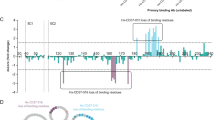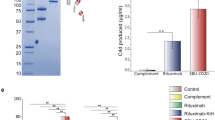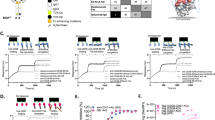Abstract
CD19 is a B-lineage-specific transmembrane signaling protein participating in the control of proliferation and differentiation. It is present at high surface density on chronic B-lymphocytic leukemia (B-CLL) cells and cells of other B-cell malignancies, and is a prime target for therapy with antibody-derived agents. Many attempts have been made to target malignant cells via CD19, but to date none of these agents have received drug approval. Here we report the design of a monovalent immunotoxin consisting of a CD19-specific single-chain Fv antibody fragment fused to a derivative of Pseudomonas Exotoxin A. This fusion protein induced efficient antigen-restricted apoptosis of several human leukemia- and lymphoma-derived cell lines including Nalm-6, which it eliminated at an effective concentration (EC50) of 2.5 nM. The agent displayed synergistic toxicity when used in combination with valproic acid and cyclosporin A in cell-culture assays. It induced apoptosis of primary malignant cells in 12/12 samples from B-CLL patients, including patients responding poorly to fludarabine, and of cells from one pediatric acute lymphoblastic leukemia patient. In NOD/SCID mice transplanted with Nalm-6 cells, the toxin prevented engraftment and significantly prolonged survival of treated mice. Owing to its efficient antigen-restricted antileukemic activity, the agent deserves further development towards clinical testing.
This is a preview of subscription content, access via your institution
Access options
Subscribe to this journal
Receive 12 print issues and online access
$259.00 per year
only $21.58 per issue
Buy this article
- Purchase on Springer Link
- Instant access to full article PDF
Prices may be subject to local taxes which are calculated during checkout





Similar content being viewed by others
References
Fearon DT, Carroll MC . Regulation of B lymphocyte responses to foreign and self-antigens by the CD19/CD21 complex. Annu Rev Immunol 2000; 18: 393–422.
Fujimoto M, Fujimoto Y, Poe JC, Jansen PJ, Lowell CA, DeFranco AL et al. CD19 regulates Src family protein tyrosine kinase activation in B lymphocytes through processive amplification. Immunity 2000; 13: 47–57.
Nadler LM, Anderson KC, Marti G, Bates M, Park E, Daley JF et al. B4, a human B lymphocyte-associated antigen expressed on normal, mitogen-activated, and malignant B lymphocytes. J Immunol 1983; 131: 244–250.
Press OW, Farr AG, Borroz KI, Anderson SK, Martin PJ . Endocytosis and degradation of monoclonal antibodies targeting human B-cell malignancies. Cancer Res 1989; 49: 4906–4912.
Hekman A, Honselaar A, Vuist WM, Sein JJ, Rodenhuis S, ten Bokkel Huinink WW et al. Initial experience with treatment of human B cell lymphoma with anti-CD19 monoclonal antibody. Cancer Immunol Immunother 1991; 32: 364–372.
Pietersz GA, Wenjun L, Sutton VR, Burgess J, McKenzie IF, Zola H et al. In vitro and in vivo antitumor activity of a chimeric anti-CD19 antibody. Cancer Immunol Immunother 1995; 41: 53–60.
Lang P, Barbin K, Feuchtinger T, Greil J, Peipp M, Zunino SJ et al. Chimeric CD19 antibody mediates cytotoxic activity against leukemic blasts with effector cells from pediatric patients who received T-cell-depleted allografts. Blood 2004; 103: 3982–3985.
Yazawa N, Hamaguchi Y, Poe JC, Tedder TF . Immunotherapy using unconjugated CD19 monoclonal antibodies in animal models for B lymphocyte malignancies and autoimmune disease. Proc Natl Acad Sci USA 2005; 102: 15178–15183.
Umana P, Jean-Mairet J, Moudry R, Amstutz H, Bailey JE . Engineered glycoforms of an antineuroblastoma IgG1 with optimized antibody-dependent cellular cytotoxic activity. Nat Biotechnol 1999; 17: 176–180.
Barbin K, Stieglmaier J, Saul D, Stieglmaier K, Stockmeyer B, Pfeiffer M et al. Influence of variable N-glycosylation on the cytolytic potential of chimeric CD19 antibodies. J Immunother 2006; 29: 122–133.
Johnson P, Glennie M . The mechanisms of action of rituximab in the elimination of tumor cells. Semin Oncol 2003; 30: 3–8.
De Gast GC, Van Houten AA, Haagen IA, Klein S, De Weger RA, Van Dijk A et al. Clinical experience with CD3 × CD19 bispecific antibodies in patients with B cell malignancies. J Hematother 1995; 4: 433–437.
Manzke O, Tesch H, Lorenzen J, Diehl V, Bohlen H . Locoregional treatment of low-grade B-cell lymphoma with CD3 × CD19 bispecific antibodies and CD28 costimulation. II. Assessment of cellular immune responses. Int J Cancer 2001; 91: 516–522.
Peipp M, Valerius T . Bispecific antibodies targeting cancer cells. Biochem Soc Trans 2002; 30: 507–511.
Kipriyanov SM, Cochlovius B, Schafer HJ, Moldenhauer G, Bahre A, Le Gall F et al. Synergistic antitumor effect of bispecific CD19 × CD3 and CD19 × CD16 diabodies in a preclinical model of non-Hodgkin's lymphoma. J Immunol 2002; 169: 137–144.
Dreier T, Baeuerle PA, Fichtner I, Grun M, Schlereth B, Lorenczewski G et al. T cell costimulus-independent and very efficacious inhibition of tumor growth in mice bearing subcutaneous or leukemic human B cell lymphoma xenografts by a CD19-/CD3- bispecific single-chain antibody construct. J Immunol 2003; 170: 4397–4402.
Bruenke J, Barbin K, Kunert S, Lang P, Pfeiffer M, Stieglmaier K et al. Effective lysis of lymphoma cells with a stabilised bispecific single-chain Fv antibody against CD19 and FcgammaRIII (CD16). Br J Haematol 2005; 130: 218–228.
Molhoj M, Crommer S, Brischwein K, Rau D, Sriskandarajah M, Hoffmann P et al. CD19-/CD3-bispecific antibody of the BiTE class is far superior to tandem diabody with respect to redirected tumor cell lysis. Mol Immunol 2007; 44: 1945–1953.
Bader P, Hancock J, Kreyenberg H, Goulden NJ, Niethammer D, Oakhill A et al. Minimal residual disease (MRD) status prior to allogeneic stem cell transplantation is a powerful predictor for post-transplant outcome in children with ALL. Leukemia 2002; 16: 1668–1672.
Conry RM, Khazaeli MB, Saleh MN, Ghetie V, Vitetta ES, Liu T et al. Phase I trial of an anti-CD19 deglycosylated ricin A chain immunotoxin in non-Hodgkin's lymphoma: effect of an intensive schedule of administration. J Immunother Emphasis Tumor Immunol 1995; 18: 231–241.
Flavell DJ, Flavell SU, Boehm DA, Emery L, Noss A, Ling NR et al. Preclinical studies with the anti-CD19-saporin immunotoxin BU12-SAPORIN for the treatment of human-B-cell tumours. Br J Cancer 1995; 72: 1373–1379.
Messmann RA, Vitetta ES, Headlee D, Senderowicz AM, Figg WD, Schindler J et al. A phase I study of combination therapy with immunotoxins IgG-HD37-deglycosylated ricin A chain (dgA) and IgG-RFB4-dgA (Combotox) in patients with refractory CD19(+), CD22(+) B cell lymphoma. Clin Cancer Res 2000; 6: 1302–1313.
Stone MJ, Sausville EA, Fay JW, Headlee D, Collins RH, Figg WD et al. A phase I study of bolus versus continuous infusion of the anti-CD19 immunotoxin, IgG-HD37-dgA, in patients with B-cell lymphoma. Blood 1996; 88: 1188–1197.
Smallshaw JE, Ghetie V, Rizo J, Fulmer JR, Trahan LL, Ghetie MA et al. Genetic engineering of an immunotoxin to eliminate pulmonary vascular leak in mice. Nat Biotechnol 2003; 21: 387–391.
Barth S, Huhn M, Matthey B, Tawadros S, Schnell R, Schinkothe T et al. Ki-4(scFv)-ETA′, a new recombinant anti-CD30 immunotoxin with highly specific cytotoxic activity against disseminated Hodgkin tumors in SCID mice. Blood 2000; 95: 3909–3914.
Kreitman RJ, Wilson WH, White JD, Stetler-Stevenson M, Jaffe ES, Giardina S et al. Phase I trial of recombinant immunotoxin anti-Tac(Fv)-PE38 (LMB-2) in patients with hematologic malignancies. J Clin Oncol 2000; 18: 1622–1636.
Peipp M, Kupers H, Saul D, Schlierf B, Greil J, Zunino SJ et al. A recombinant CD7-specific single-chain immunotoxin is a potent inducer of apoptosis in acute leukemic T cells. Cancer Res 2002; 62: 2848–2855.
von Minckwitz G, Harder S, Hovelmann S, Jager E, Al-Batran SE, Loibl S et al. Phase I clinical study of the recombinant antibody toxin scFv(FRP5)-ETA specific for the ErbB2/HER2 receptor in patients with advanced solid malignomas. Breast Cancer Res 2005; 7: R617–R626.
Schwemmlein M, Peipp M, Barbin K, Saul D, Stockmeyer B, Repp R et al. A CD33-specific single-chain immunotoxin mediates potent apoptosis of cultured human myeloid leukaemia cells. Br J Haematol 2006; 133: 141–151.
Kreitman RJ, Squires DR, Stetler-Stevenson M, Noel P, FitzGerald DJ, Wilson WH et al. Phase I trial of recombinant immunotoxin RFB4(dsFv)-PE38 (BL22) in patients with B-cell malignancies. J Clin Oncol 2005; 23: 6719–6729.
Thorpe SJ, Turner C, Heath A, Feavers I, Vatn I, Natvig JB et al. Clonal analysis of a human antimouse antibody (HAMA) response. Scand J Immunol 2003; 57: 85–92.
Baluna R, Rizo J, Gordon BE, Ghetie V, Vitetta ES . Evidence for a structural motif in toxins and interleukin-2 that may be responsible for binding to endothelial cells and initiating vascular leak syndrome. Proc Natl Acad Sci USA 1999; 96: 3957–3962.
Greil J, Gramatzki M, Burger R, Marschalek R, Peltner M, Trautmann U et al. The acute lymphoblastic leukaemia cell line SEM with t(4;11) chromosomal rearrangement is biphenotypic and responsive to interleukin-7. Br J Haematol 1994; 86: 275–283.
Peipp M, Saul D, Barbin K, Bruenke J, Zunino SJ, Niederweis M et al. Efficient eukaryotic expression of fluorescent scFv fusion proteins directed against CD antigens for FACS applications. J Immunol Methods 2004; 285: 265–280.
Nicoletti I, Migliorati G, Pagliacci MC, Grignani F, Riccardi C . A rapid and simple method for measuring thymocyte apoptosis by propidium iodide staining and flow cytometry. J Immunol Methods 1991; 139: 271–279.
Einsiedel HG, Kawan L, Eckert C, Witt O, Fichtner I, Henze G et al. Histone deacetylase inhibitors have antitumor activity in two NOD/SCID mouse models of B-cell precursor childhood acute lymphoblastic leukemia. Leukemia 2006; 20: 1435–1436.
Zunino SJ, Storms DH . Resveratrol-induced apoptosis is enhanced in acute lymphoblastic leukemia cells by modulation of the mitochondrial permeability transition pore. Cancer Lett 2006; 240: 123–134.
Dohner H, Stilgenbauer S, Benner A, Leupolt E, Krober A, Bullinger L et al. Genomic aberrations and survival in chronic lymphocytic leukemia. N Engl J Med 2000; 343: 1910–1916.
Roy MK, Takenaka M, Kobori M, Nakahara K, Isobe S, Tsushida T . Apoptosis, necrosis and cell proliferation-inhibition by cyclosporine A in U937 cells (a human monocytic cell line). Pharmacol Res 2006; 53: 293–302.
Andersson Y, Juell S, Fodstad O . Downregulation of the antiapoptotic MCL-1 protein and apoptosis in MA-11 breast cancer cells induced by an anti-epidermal growth factor receptor-Pseudomonas exotoxin a immunotoxin. Int J Cancer 2004; 112: 475–483.
Flavell DJ, Warnes SL, Bryson CJ, Field SA, Noss AL, Packham G et al. The anti-CD20 antibody rituximab augments the immunospecific therapeutic effectiveness of an anti-CD19 immunotoxin directed against human B-cell lymphoma. Br J Haematol 2006; 134: 157–170.
Thomas M, Gessner A, Vornlocher HP, Hadwiger P, Greil J, Heidenreich O . Targeting MLL-AF4 with short interfering RNAs inhibits clonogenicity and engraftment of t(4;11)-positive human leukemic cells. Blood 2005; 106: 3559–3566.
Dorrie J, Gerauer H, Wachter Y, Zunino SJ . Resveratrol induces extensive apoptosis by depolarizing mitochondrial membranes and activating caspase-9 in acute lymphoblastic leukemia cells. Cancer Res 2001; 61: 4731–4739.
Dorrie J, Sapala K, Zunino SJ . Carnosol-induced apoptosis and downregulation of Bcl-2 in B-lineage leukemia cells. Cancer Lett 2001; 170: 33–39.
Rothe G, Schmitz G . Consensus protocol for the flow cytometric immunophenotyping of hematopoietic malignancies. Working Group on Flow Cytometry and Image Analysis. Leukemia 1996; 10: 877–895.
Cox CV, Evely RS, Oakhill A, Pamphilon DH, Goulden NJ, Blair A . Characterization of acute lymphoblastic leukemia progenitor cells. Blood 2004; 104: 2919–2925.
Castor A, Nilsson L, Astrand-Grundstrom I, Buitenhuis M, Ramirez C, Anderson K et al. Distinct patterns of hematopoietic stem cell involvement in acute lymphoblastic leukemia. Nat Med 2005; 11: 630–637.
Acknowledgements
We thank Dr W Wels for the Pseudomonas ETA cDNA, and Dr Torsten Haferlach for determining the p53 status of the B-CLL patients. We also thank Th Lange for administrative assistance. This study was supported by research grant 2003.015.1 from the Wilhelm Sander Stiftung, Neustadt, Germany; Association of Supporters of the University Children's Hospital, Erlangen, Germany; Association ‘Kaminkehrer helfen krebskranken Kindern’, Untersiemau, Germany (to GHF); Beitlich Foundation, Tuebingen, Germany (to PL and GHF); Research Training Grant GK592 from the Deutsche Forschungsgemeinschaft; intramural funding from the University of Erlangen's ELAN program; stipends from the Sofie Wallner-Stiftung, Erlangen, Germany (to MS); Schickedanz KinderKrebs Stiftung, Fuerth, Germany (to JS).
Author information
Authors and Affiliations
Corresponding author
Rights and permissions
About this article
Cite this article
Schwemmlein, M., Stieglmaier, J., Kellner, C. et al. A CD19-specific single-chain immunotoxin mediates potent apoptosis of B-lineage leukemic cells. Leukemia 21, 1405–1412 (2007). https://doi.org/10.1038/sj.leu.2404687
Received:
Revised:
Accepted:
Published:
Issue Date:
DOI: https://doi.org/10.1038/sj.leu.2404687
Keywords
This article is cited by
-
Improving the cytotoxicity of immunotoxins by reducing the affinity of the antibody in acidic pH
Journal of Translational Medicine (2023)
-
The novel tribody [(CD20)2xCD16] efficiently triggers effector cell-mediated lysis of malignant B cells
Leukemia (2013)
-
Antibody-based Therapeutics for the Treatment of Human B cell Malignancies
Current Allergy and Asthma Reports (2013)



